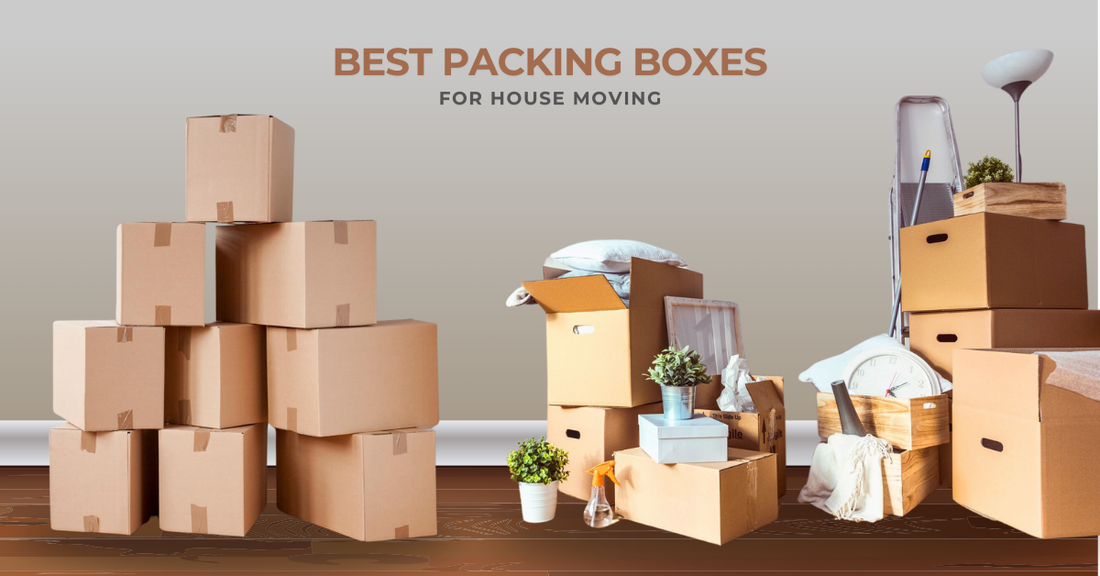Selecting the ideal packing materials is a key component to making your move smooth and stress-free. Cardboard boxes form the core of your packing plan and are critical for safeguarding your possessions. Whether you're moving nearby or relocating to a different city, choosing the right boxes and packing accessories is essential for protecting your belongings. This guide will equip you with the knowledge to make informed decisions, ensuring an efficient and well-organized move.
Why Choosing the Right Moving Box Matters?
The strength and dimensions of your boxes are pivotal in determining how safe your items will be during the move. Using weak or inappropriately sized boxes can lead to damage. For example, fragile items may break if packed in boxes not designed for delicate objects, while overstuffed smaller boxes may collapse under pressure. By investing in sturdy, properly sized boxes, you can avoid common moving mishaps, ultimately saving time and money.
Types of Packing Boxes for Moving
Not all packing boxes are equal, and selecting the right ones is crucial for a successful move. Here’s a breakdown of the most common types:
- Standard Cardboard Boxes: These come in various sizes and are versatile for packing household items such as books, kitchen supplies, and decor.
- Wardrobe Boxes: Designed to transport clothing on hangers, keeping them wrinkle-free and easy to unpack.
- Dish Packs: Built with dividers and padding, these are ideal for safely transporting glassware, dishes, and other delicate kitchen items.
- Archive Boxes: Sturdy boxes specifically made for documents or papers, helping keep important records safe during the move.
By using the correct type of box for each item, you can significantly reduce the risk of damage and simplify unpacking once you reach your new home.
How to Select the Right Box Size
Choosing boxes of the right size is crucial to ensure the safety and efficiency of your move. Large boxes are ideal for lightweight items like bedding or clothing, whereas smaller boxes are best for heavier objects like books. A common mistake is overfilling large boxes with heavy items, making them harder to carry and more likely to break. It's generally best to place heavier items in smaller boxes and lighter items in larger ones.
Before you begin packing, evaluate the size and weight of your belongings. This will guide your selection of box sizes, ensuring the move goes smoothly and safely.
Essential Packing Accessories for a Hassle-Free Move
Beyond boxes, there are several other packing tools that are necessary to make your move more manageable:
- Bubble Wrap: Protects delicate items such as glassware and ceramics from breaking during transit.
- Packing Tape: Ensures that your boxes stay securely closed throughout the move.
- Markers: Used for labeling boxes to make unpacking easier and more efficient.
- Packing Paper: Provides an additional layer of protection for fragile items and serves as padding to prevent items from shifting inside boxes.
These tools help protect your belongings and keep everything well-organized during the move.
The Importance of Box Strength and Durability
When packing heavier or fragile items, the durability of your boxes is key. Double-walled boxes, which consist of two layers of cardboard, offer superior strength compared to single-walled boxes. These boxes are less likely to bend or break under the weight of your possessions, making them ideal for items like books or appliances.
For peace of mind during the move, it’s often worth opting for double-walled boxes, particularly when transporting valuables or heavy objects.
Eco-Friendly Moving Options
With more people seeking environmentally friendly choices, eco-conscious moving solutions like recyclable boxes and biodegradable packing materials are becoming more popular. You can find boxes made from recycled materials that are fully recyclable after use.
Another option is to reuse boxes from previous moves or get them from local businesses. You can also consider renting reusable plastic crates as an alternative to traditional cardboard boxes, reducing your environmental impact.
How Many Boxes Will You Need?
A common question people have during a move is, "How many boxes will I need?" The number of boxes depends on the size of your home and the amount of belongings. As a general estimate:
- A one-bedroom home requires about 20 to 30 boxes.
- A two-bedroom home typically needs around 40 to 50 boxes.
- A three-bedroom home may require 60 to 80 boxes.
- A four-bedroom home could need 100 boxes or more.
You may also need specialty boxes, such as wardrobe boxes for clothes or dish packs for kitchenware.
Single-Walled vs. Double-Walled Boxes: Which Is Best?
Double-walled boxes are much stronger and are recommended for heavier or fragile items, whereas single-walled boxes are better suited for lighter objects. If you’re unsure, it’s generally safer to choose double-walled boxes, particularly for items of high value or those prone to breakage.
Tips to Maximize Box Space and Protect Items
After selecting the right boxes, here are some packing tips to make the most of your space and avoid damage:
1. Fill Empty Spaces: Use materials like bubble wrap, packing paper, or towels to fill any gaps in your boxes. This prevents items from moving around and reduces the chance of breakage during transit.
2. Avoid Overpacking: Don't overload boxes with too many heavy items. This makes them difficult to carry and increases the likelihood of the box breaking. Instead, distribute the weight evenly across multiple smaller boxes.
3. Label Each Box Clearly: Mark each box with its contents and the room it should go in at your new home. This makes unpacking easier and helps keep the move organized.
Conclusion
Choosing the right packing materials, boxes, and accessories is crucial to a successful move. By selecting durable boxes, using appropriate sizes, and packing thoughtfully, you can ensure your belongings arrive safely. Follow these tips for a more organized, efficient moving experience.





